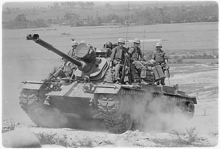M48 Patton
| M48 Patton | |
|---|---|
|
M48 Patton on display in Thun, Switzerland | |
| Type | Main battle tank[1] |
| Place of origin | United States |
| Service history | |
| In service | 1953–1990s U.S |
| Wars |
1958 Lebanon crisis Portuguese Colonial War Vietnam War Six-Day War Indo-Pakistani War of 1965 Indo-Pakistani War of 1971 Yom Kippur War[2] Western Sahara War Lebanese Civil War Turkish invasion of Cyprus Iran–Iraq War Battle of Mogadishu (1993) Turkey–PKK conflict 2007 Lebanon conflict |
| Production history | |
| Manufacturer | M48: Chrysler, Fisher Body, Ford Motor Company, American Locomotive Company |
| Produced | M48: 1952–1959 |
| Number built | M48: ≈12,000 |
| Variants | Many, see the variants section |
| Specifications | |
| Weight | M48: 49.6 short tons (44.3 long tons; 45.0 t) combat ready |
| Length | 9.3 m (30 ft 6 in) |
| Width | 3.65 m (12 ft 0 in) |
| Height | 3.1 m (10 ft 2 in) |
| Crew | 4 (commander, gunner, loader, driver) |
|
| |
| Armor |
Upper Glacis: 110 mm (4.3 in) at 60° = 220 mm (8.7 in) LoS Turret Front: 178 mm (7.0 in) at 0°[3] |
Main armament | 90 mm T54; M48A3 90 mm gun M41; M48A5 and later variants: 105 mm M68 gun |
Secondary armament |
.50 cal (12.7 mm) M2 Browning machine gun .30 cal (7.62 mm) M73 Machine gun |
| Engine |
Continental AVSI-1790-6 V12, air-cooled Twin-turbo gasoline engine (early M48s) 810 SAE gross hp = 650 DIN hp (478 kW) 750 hp (560 kW) |
| Power/weight | 16.6 hp (12.4 kW)/tonne |
| Transmission | General Motors CD-850-4A or -4B, 2 ranges forward, 1 reverse |
| Suspension | Torsion bar suspension |
| Fuel capacity | 200 US gal (760 l; 170 imp gal) |
Operational range | M48 and M48A1 113 km, M48A2 258 km, M48A3 463 km, M48A5 499 km (all on road)[4] |
| Speed | M48A5: 30 mph (48 km/h) |
The M48 Patton is a main battle tank (MBT) that was designed in the United States. It was the third tank[5] to be officially named after General George S. Patton, commander of the U.S. Third Army[6] during World War II and one of the earliest American advocates for the use of tanks in battle.[7] It was a further development of the M47 Patton tank. The M48 Patton was in U.S. service until replaced by the M60[6] and served as the U.S. Army and Marine Corps's primary battle tank in South Vietnam during the Vietnam War. It was widely used by U.S. Cold War allies, especially other NATO countries.
The M48 Patton tank was designed to replace the previous M47 Pattons and M4 Shermans. Although largely resembling the M47, the M48 was a completely new design. It was the last U.S. tank to mount the 90 mm tank gun, with the last model, the M48A5, being upgraded to carry the new standard weapon of the M60, the 105mm gun. Some M48A5 models served well into the 1980s with American forces, and many M48s remain in service in other countries. The Turkish Army has the largest number of modernized M48 MBTs, with more than 1,400 in its inventory. Of these, around 1,000 have been phased out, placed in storage, or modified as ARVs.
History
On 27 February 1951, OTCM (Ordnance Technical Committee Minutes) #33791 initiated the design of the new tank, designated the 90mm Gun Tank T-48 (the prefix letter "T" would be replaced by the prefix "X" beginning with the M60 series tank).[8] A deeper modernization than the M46 and the M47, the M48 featured a new hemispherical turret, a redesigned hull, and an improved suspension. The hull machine gunner position was removed, reducing the crew to four. On 2 April 1953, OTCM order #34765 standardized the last of the Patton series tanks as the 90mm Gun Tank M48 Patton.[6]
Nearly 12,000 M48s were built from 1952 to 1959. The early designs, up to the M48A2C's, were powered by a gasoline 12-cylinder engine and a 1-cylinder auxiliary generator (called the "Little Joe"). The gasoline engine versions gave the tank a shorter operating range and were more prone to catching fire when hit. Although considered less reliable than diesel powered versions, numerous examples saw combat use in various Arab-Israeli conflicts. The low flashpoint of MIL-PRF-6083 hydraulic fluid used in the recoil mechanisms and hydraulic systems for rotating weapons or aiming devices is less than 212 °F (100 °C) and could result in a fireball in the crew compartment when the lines were ruptured by incoming fire.[9] MIL-PRF-6083 fluid was not peculiar to the M-48 and is no longer used in combat armored vehicles, having been replaced by fire resistant hydraulic fluid. Beginning in 1959, most American M48s were upgraded to the M48A3 model, which featured a more reliable and longer range diesel power plant. M48s with gasoline engines, however, were still in use in the US Army through 1968, and through 1975 by many West German Army units, including the 124th Panzer Battalion.
M48A3
In February 1963, the US Army accepted the first of 600 M48 Patton tanks that had been converted to M48A3's, and by 1964 the US Marine Corps had received 419 Patton tanks. The A3 model introduced the diesel engine, countering the earlier versions' characteristic of catching fire.[10] These Pattons were to be deployed to battle in Vietnam.[6] Because all M48A3 tanks were conversions from earlier models, many characteristics varied among individual examples of this type. M48A3 tanks could have either three or five support rollers on each side and might have either the early or later type headlight assemblies.
M48A5
In the mid-1970s, the M48 series Tank upgrade was developed to allow the vehicle to carry the heavier 105 mm gun. The original program designation was XM736. The designation was subsequently changed to M48A3E1 and was finally standardized as M48A5. As many components from the M60A1 were utilized as possible. Anniston Army Depot was issued a contract to convert 501 M48A3 tanks to the M48A5 standard and this was completed in December 1976. These early M48A5's were essentially M48A3 tanks with the 105mm gun added. They retained the M1 cupola armed with a .50 cal machine gun.[6]
Based on Israeli experience in upgrading M48 series tanks, further changes were instituted during the conversion process. These changes began to be incorporated in August 1976. These included replacing the M1 cupola with a low-profile "Urdan" type cupola that mounted an M60D machine gun for use by the tank commander. A second M60D machine gun was mounted on the turret roof for use by the loader. Internal ammunition stowage for the 105mm main gun was also increased to 54 rounds. These tanks were initially given the designation M48A5API; but, after early conversions were brought up to the later standard, the API was removed and these tanks were known simply as M48A5.[6]
In addition to the conversion of M48A3 tanks, an additional conversion process for bringing M48A1 tanks to M48A5 standard was also developed. By March 1978, 708 M48A5 tanks had been converted from the M48A1 model.[6]
Work continued until December 1979, at which time 2069 M48A5's had been converted.[6]
The vast majority of M48A5 tanks in service with US Army units were assigned to National Guard and Army Reserve Units. A notable exception was the 2nd Infantry Division in the Republic of Korea, who replaced their M60A1 tanks with M48A5's, which arrived in June and July 1978. On 2nd Infantry Division M48A5 tanks the commanders M60D was replaced with a .50 caliber M2 machine gun.[6]
By the mid-1990s, the M48s were phased out of U.S. service. Many other countries, however, continued to use these M48 models.
Combat service
Vietnam
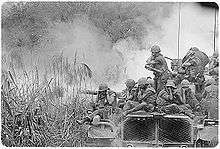
The M48s saw extensive action during the Vietnam War. Over 600 Pattons would be deployed with US Forces during the war.[11] The initial M48s landed with the US Marine 1st and 3rd Tank Battalions in 1965;[12] the Marine 5th Tank Battalion would later become a reinforcement unit. Remaining Pattons deployed to South Vietnam were in three U.S. Army battalions, the 1-77th Armor near the DMZ (67 M48A2C (23 tanks supplied from US Army Training Center at Fort Knox, KY USA and 44 tanks from Letterkenney Army Depot Chambersburg PA USA) tanks were used by the 77th Armor from August 1968 to January 1969. These were replaced with M48A3s), the 1-69th Armor in the Central Highlands, and the 2-34th Armor near the Mekong Delta. Each battalion consisted of approximately 57 tanks. M48s were also used by Armored Cavalry Squadrons in Vietnam, until replaced by M551 Sheridan Armored Reconnaissance Airborne Assault Vehicles (ARAAV) in the Divisional Cavalry Squadrons. M48A3 tanks remained in service with the 11th Armored Cavalry Regiment until the unit was withdrawn. The M67A1 flamethrower tank (nicknamed the Zippo) was an M48 variant used in Vietnam.
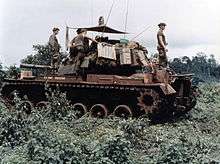
The M48 Patton has the distinction of playing a unique role in an event that was destined to radically alter the conduct of armored warfare.[12] When US forces commenced redeployment operations, many of the M48A3 Pattons were turned over to the Army of the Republic of Vietnam (ARVN) forces, in particular creating the battalion-sized ARVN 20th Tank Regiment; which supplemented their M41 Walker Bulldog units. During the North Vietnamese Army (NVA) Easter Offensive in 1972, tank clashes between NVA T-54/PT-76 and ARVN M48/M41 units became commonplace. But, on 23 April 1972, tankers of the 20th Tank Regiment were attacked by an NVA infantry-tank team, which was equipped with the new 9M14M Malyutka (NATO designation: Sagger) wire guided anti-tank missile. During this battle, one M48A3 Patton tank and one M113 Armored Cavalry Assault Vehicle (ACAV) were destroyed, becoming the first losses to the Sagger missile; losses that would echo on an even larger scale a year later during the Yom Kippur War in the Middle East in 1973.[12]
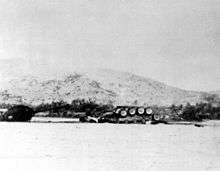
The M48s performed admirably[13] in Vietnam in the infantry-support role. However, there were few actual tank versus tank battles. One was between the US 1-69th Armor and PT-76 light amphibious tanks of the NVA 202nd Armored Regiment at Ben Het Camp in March 1969.[12] The M48s provided adequate protection for its crew from small arms, mines, and rocket-propelled grenades. South Vietnamese M48s and M41s fought in the so-called Ho Chi Minh Offensive in 1975. In several incidents, the South Vietnamese Army successfully defeated NVA T-34 and T-55 tanks and even slowed the North's offensive. However, since the United States Congress passed bans on the transfer of fuel and ammunition to South Vietnam, the American-made tanks were soon out of ammunition and fuel and were abandoned to the North Vietnamese Army in 1975, which put them in predictably short service of the Vietnamese People's Army after the war ended in May 1975.
M48s, alongside Australian 20 pounder (84mm) gunned[14] Centurions of the 1st Armoured Regiment,[12] were the only vehicles in Vietnam that could reasonably protect their crews from land mines. They were often used for minesweeping operations along Highway 19 in the Central Highlands, a two lane paved road between An Khe and Pleiku. Daily convoys moved both ways along Highway 19. These convoys were held up each morning while the road was swept for mines. At that time, minesweeping was done by soldiers walking slowly over the dirt shoulders of the highway with hand-held mine detectors. During this slow process, convoys would build up into a dangerously inviting target for the enemy. As a result, a faster method was improvised, the "Thunder Run", in which one M48 lined up on each side of the road, with one track on the dirt shoulder and the other track on the asphalt; then with all guns firing,[15] they raced to a designated position miles away. If the M48s made it without striking a mine, the road was clear and the convoys could proceed. In most cases, an M48 that struck a land mine in these operations only lost a road wheel or two in the explosion; seldom was there any hull damage that would be considered "totaling" the tank.[16]
Indo-Pakistani Wars

M47s and M48s were again used in tank warfare by the Pakistan Army against Indian Army Centurion and M4 Sherman tanks in the Indo-Pakistani War of 1965 with some good results. During Operation Grand Slam, Pakistani tank forces thrust through the Indian lines very quickly, and defeated armored counterattacks. The Pakistanis used approximately a division's worth of tanks, though not all were Pattons. The Patton failed to live up to expectations in the Battle of Asal Uttar (September 1965), where about 97 Pakistani tanks were lost, the majority of them being Pattons. Later, the tank was the main Pakistani tank at the Battle of Chawinda and its performance at that battle was deemed satisfactory.
The Patton was later used by Pakistan in the Indo-Pakistani War of 1971, with mixed results. In a repetition of 1965, Pattons spearheaded the Pakistani advance through Chamb, and the Patton was the main Pakistani tank at Shakarghar. In the latter battle, a brigade of tanks (the Changez Force) successfully resisted the Indian advance, in a repeat of Chawinda. However, in what became known as Pakistan's Charge of the Light Brigade, a counterattack led by the 13th Lancers and 31st Cavalry was defeated by the Indian 54th Division around Battle of Barapind (December 1971). India later set up a war memorial named "Patton Nagar" ("Patton City") in Khemkaran District, where the captured Pakistani Patton tanks are displayed.
Analyzing their performance, the Pakistani Army held that the Patton was held in reasonably high esteem by both sides and that tactics were to blame for the debacle at Asal Uttar. However, a U.S. study of the battles in South Asia concluded that the Patton's armor could in fact be penetrated by the 20 pounder gun (84 mm) of the Centurion as well as the 75 mm gun of the AMX-13.
Middle East

M48s were also used with mixed results during the 1967 Six-Day War. On the Sinai front, Israeli M48s up-gunned with 105 mm L7 rifled guns were used with success against Egyptian IS-3s, T-54s, T-34s and SU-100s supplied by the Soviet Union in the second battle of Abu-Ageila. However, on the West Bank front, Jordanian M48s were often defeated by Israeli 105mm Centurions and WWII-era M4 Shermans (M-51s up-gunned with 105 mm guns). In pure technical terms, the Pattons were far superior to the Shermans, with shots at more than 1,000 meters simply glancing off the M48s' armor. However, the 105 mm gun of the Israeli Shermans fired a HEAT round designed to defeat the T-62 tank, which was the Soviet response to the M48's successor in US service, the M60. The Jordanian Pattons' failure on the West Bank could also be attributed to Israeli air superiority. The Israeli Army captured about 100 Jordanian M48 and M48A1 tanks and pressed them into service in their own units after the war.
M48s were used by the Israel Defense Forces, the Lebanese Army, the Christian Lebanese Forces militia, the Druze Progressive Socialist Party's People’s Liberation Army militia and the South Lebanon Army in the Lebanese Civil War. On 10 June 1982, ten Israeli M48A3s and some APCs were lost in an ambush by Syrian T-55 tanks and BMP-1 APCs during the Battle of Sultan Yacoub.
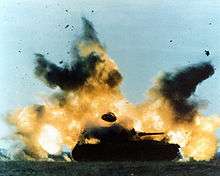
The Lebanese Army still operates about 100 M48s. In 2007, during the 2007 North Lebanon conflict Lebanese Army M48s shelled militant outposts in a refugee camp.[17][18]
Together with the M47, M48 tanks were used by the Turkish Armed Forces during the Turkish invasion of Cyprus in 1974. The Turkish Armed Forces in Northern Cyprus continue to use M48 tanks today.
When the Turkey-PKK conflict began the Turkish Armed Forces has a number of M48s. They were used in the 1980s and 1990s as static artillery, used in defending military base perimeters.
Iranian M48 tanks were used widely in the Iran–Iraq War.
Africa
In 1973, Morocco took its first M48A3s. By the end of the 70's further deliveries of M48A5 were performed and the upgrade to M48A5 was achieved locally with aid of US consultants. In 1987, a final shipment of 100 M-48A5 tanks from the Wisconsin National Guard were delivered to the Moroccan army.there are unconfirmed reports of deliveries of Israelis M48A5 during the 80's. The tanks were used in the Western Sahara desert against Polisario guerrillas with great success. The M48 superior fire control system and APFSDS rounds proved fatal against Polisario's T-55s.
Pakistan used M48 Pattons while reinforcing American troops during the Battle of Mogadishu in 1993.[19]
Variants
U.S.

- M48: Differed from the M47 in having yet another new turret design and a redesigned hull, doing away with the bow machine gun position, featuring the M41 90 mm gun. These turrets give the M48 its distinctive non-M26 style look. Originally, the gun featured a Y-shape muzzle brake, but this was changed to the more characteristic T-shape.
- M48C: Over a hundred original production hulls were found to be lacking correct ballistic protection and were relegated to training as the M48C.
- M48A1: New driver hatch and M1 commander's cupola, allowing the M2HB .50 caliber machine gun to be operated and reloaded from within the vehicle.
- M48A2: Improved powerpack and transmission, redesigned rear plate, and improved turret control.
- M48A2 AVLB: M48A2 chassis, fitted with a scissors-type bridge.
- M48A2C: M48A2s with an improved rangefinder, M17, new ballistic drive and bore evacuator for the main gun, and the auxiliary tensioning wheels were deleted.
- M48A3: Refit of M48A1 through M48A2C models to diesel engines and a new fire control system. 1,019 converted [20][21]
- M48A3 Mod. B: Additional armor on the exhausts and tail lights, and a raised commander's cupola.
- M48A4: Proposed refit of M48A3s with M60 turrets, scrapped with the need of these previous "surplus" turrets with the failure of the M60A2
- M48A5: Up-gunned with the 105 mm M68 gun. 2,069 converted [21]
- M48A5 AVLB: M48A5 chassis with a 60-foot scissors-type bridge.[22]
- M48A5PI: M1 cupola replaced by the Israeli Urdan model.
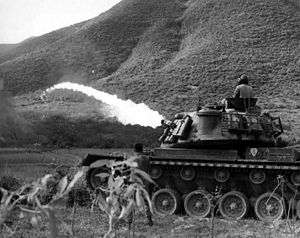
- M67 "Zippo": M48 armed with a flamethrower inside a dummy model of the main gun with a fake muzzle brake. Named after a popular brand of cigarette lighter.
- M247 Sergeant York: This self-propelled anti-aircraft gun, cancelled in 1985 before it was deployed, used the M48A5 chassis.[23]
Specialized variants
- M48DB: (M48 Dozer Blade) Outfitted with dozer blade type M8 and M8A1 (Bulldozer, Earth Moving, Tank Mounting M8/M8A1)
- M48A1DB: Improved M48 tank with equipment as above
- M48A2DB German Army version
- M48A1DB: Improved M48 tank with equipment as above
Israeli
Israel created an extensive number of variants of the series from tanks acquired initially from a number of sources, including capturing them in battle, or from other countries, such as Germany and the United States. Many of the Israeli M48's have been upgraded with additional reactive or passive armor, drastically improving their armor protection. These uparmored versions are called Magach.
- E-48
- E-48 AVLB: An M48 AVLB but with an Israeli bridge.
- E-48 (M48A2): An unmodified M48A2 from Germany.
- E-48 (M48A2C): German designation for the M48A2C.
- E-48 (M48A3): US-made M48A3 in German service.
- Magach: A series of improved Israeli versions of the M48 and the M60.
Republic of China (Taiwan)

- M48A3 (Taiwan Variant): Most of Republic of China Army M48A3 began their lives as M48A1/A2 and have (unlike those serving other nations) retained the original engine compartment, the engine installation made possible by removing adjacent fuel cells, resulting in a lower operational range of 312 km.
- M48H/CM-11 "Brave Tiger": ROC M60 version utilizing an up-gunned M48A2 turret mated to an M60A3 hull. Also has significant upgrades to the gun tracking equipment and fire control.
- CM-12: M48A3 retrofitted with the same weapons and fire control upgrades as the CM-11. They retained the original engine compartment of the M48/M48A1, and the upgrade apparently included the removal of some fuel cells in the hull, resulting in a lower operational range than that of the M48A5 (the official figure being 203 km).
The picture of the Brave Tiger shows one of the first M60s with an M48 turret.
Greek
- M48A5 MOLF: The Hellenic Army has added the EMES-18 FCS to their M48A5, denumerating them as "MOLF" for Modular Laser Fire Control System. About 400 M48A5 were rebuilt at 304 Π.Ε.Β. (Hellenic Army Factory) and most of the electronics of the EMES-18 have been manufactured by ECON electronics in Greece. The MOLF system shares 80% of its parts with the EMES-18 used in Hellenic's Army 500+ Leopard 1A5GR.
Spanish

- M48A5E: 1978-79, M48A5 variant, 105 mm gun with M17B1C optical rangefinder. M13A4 ballistic computer, IR/white light projector over main armament.
- M48A5E1: improved M48A5E
- M48A5E2: 1981–1983. Hughes Mk7 fire control system with laser rangefinder and solid state ballistic computer; passive night vision equipment, Urdan cupola. 164 upgraded vehicles, retired 1997.
- M48A5E3: 1991. Prototype only. E2 with thermal sights and main gun stabilization. Cancelled in 1993.[24]
South Korean
- M48A3K: 381 vehicles were M48A1 to M48A3 Mod.A with M48A5K standard FCS. This variant uses a diesel engine instead of the original gasoline type. Other changes include installation of a T-shaped muzzle brake on the gun, three additional support wheels on the tracks, commander's periscope on the turret and smoke grenade dischargers. The fire control system has also been replaced with Laser Tank Fire Control System (LTFCS).
- M48A5K1/A5K2/A5KW: 195 M48A5K1 were converted from M48A2C, and 210 M48A5K2 were converted from M48A1. Introduced in 1980, it replaced the main gun with the KM68A1 105 mm gun.[25] Additional side skirts were provided, and the fire control system was upgraded to the Laser Tank Fire Control System (LTFCS) which incorporates LRF, digital ballistic computer and crosswind sensor.[26] M48A5K2 equips Israeli Urdan cupola. Korea also received 275 ex-USFK M48A5 in 1995, and upgraded to M48A5KW. The characteristic of M48A5KW is identical to M48A5K1/K2, but lacks side skirts.
Turkish
- M48A5T1: Turkish M48 variant upgraded along similar lines to the M60A1, with an M68 105 mm main gun, passive night vision, M60A1 fire control system and an MTU diesel engine.
- M48A5T2: Improved version of the M48A5T1 upgraded along similar lines to the M60A3 with thermal imaging, M60A3 fire control system and a laser rangefinder.
- M48T5 "Tamay" ARV: Turkish-designed remote controlled armored recovery vehicle built on the M48 chassis.
German
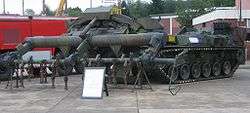
- Keiler (Mine flail) Minenräumpanzer Keiler (mine clearing tank "wild boar"), a mine flail, mine clearing vehicle based on a widely modified M48A2C cast hull. The first of 24 Keilers was supplied to the German Army by Rheinmetall in 1997.[27] This vehicle remains in service.
- Kampfpanzer M48A2C: Served together with the M47 starting in the late 1950s (the M47 was replaced by the Leopard 1). When the Leopard 2 came into service, they were sent to the Heimat-Schutzbrigaden ("home defence brigades") of the Territorialheer (Territorial Army). Many were later upgraded to M48A2GA2 standard.
- Kampfpanzer M48A2GA2: Upgraded version with the 105 mm L7 cannon and a different MG3 installation from the Leopard 1 as well as quite a few other assemblies. The tank served with tank battalions and in the 5th (heavy) company of some Jäger Battalions of the Territorial Army. 650 were converted by Wegmann (Kassel) between June 1978 and November 1980[28]

- Combat-Engineer Variants: The Bundeswehr used several Combat Engineer Variants of the M48. The early versions were based on the M48A2C with an M8 dozer blade attached but otherwise unmodified vehicles. When the M48 was upgraded to the M48A2GA2, these tanks were not upgraded but given to the Home Defense Forces and lost their gun completely. In Service until the early 1990s
- Super M48:[29] Private venture upgrade for the M48. Featured a 105 mm L7 cannon with thermal sleeve, MOLF 48 FCS, a new 1,000 hp MTU Diesel engine and add-on armor on the turret front and sides.[30] Never developed beyond a prototype/test platform stage.
Commercial upgrades
- M48 Marksman: An M48 hull with the British-designed Marksman anti-aircraft turret mounted. Not in service.
Operators

Current operators
-
 Greece: 390 M48A5 MOLF
Greece: 390 M48A5 MOLF -
 Iran: 180
Iran: 180 -
 Republic of Korea: Around 300 M48A3K and 500 M48A5K1/K2 are in service. M48A3K are expected to be replaced by the K2 Black Panther in the distant future. Most of the M48A3K are used in reserve, but ROKM continues to use a few tanks in active service. However, the ROKM's M48A3K are being replaced with K-1 Tanks
Republic of Korea: Around 300 M48A3K and 500 M48A5K1/K2 are in service. M48A3K are expected to be replaced by the K2 Black Panther in the distant future. Most of the M48A3K are used in reserve, but ROKM continues to use a few tanks in active service. However, the ROKM's M48A3K are being replaced with K-1 Tanks -
 Lebanon: 104 M48A1 and M48A5
Lebanon: 104 M48A1 and M48A5 -
 Morocco: 225 M48A5
Morocco: 225 M48A5 -
 Republic of China: 450 CM-11, 100 CM-12[31]
Republic of China: 450 CM-11, 100 CM-12[31] -
 Thailand: 105 M48A5
Thailand: 105 M48A5 -
 Tunisia: 28
Tunisia: 28 -
 Turkey: 758 M48A5T2 in service. All other variants, 2,250 pieces including the 1,389 M48A5T1 are phased out of active service.
Turkey: 758 M48A5T2 in service. All other variants, 2,250 pieces including the 1,389 M48A5T1 are phased out of active service.
Former operators
-
 Israel: 561 Magach 5 Golan[32]
Israel: 561 Magach 5 Golan[32] -
 Jordan: 200 M48A1
Jordan: 200 M48A1 -
 Norway: 38 M48A5
Norway: 38 M48A5 -
 Pakistan: 300 M48A5's in active service till 2002, Currently in Reserve.[33][34]
Pakistan: 300 M48A5's in active service till 2002, Currently in Reserve.[33][34] -
 Portugal: M48A5 phased out and replaced by 96 M60A3 TTS and 38 Leopard-2A6's.
Portugal: M48A5 phased out and replaced by 96 M60A3 TTS and 38 Leopard-2A6's. -
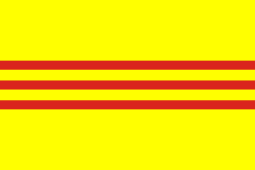 South Vietnam: Few hundred. 20 passed on to Socialist Republic of Vietnam.
South Vietnam: Few hundred. 20 passed on to Socialist Republic of Vietnam. -
 Spain: 164 M48A5E
Spain: 164 M48A5E -
 West Germany except 24 Minenräumpanzer Keiler
West Germany except 24 Minenräumpanzer Keiler -
 Vietnam: 20 M48s, retired due to lack of spare parts.
Vietnam: 20 M48s, retired due to lack of spare parts. -
 United States of America
United States of America
See also
- M46 Patton
- M47 Patton
- M60 Patton
- M88 Recovery Vehicle – armored recovery variant based on the M48 Patton/M60 Series tanks chassis and part of the automotive component.
- M103 heavy tank
- List of armoured fighting vehicles
- G-numbers – SNL G254
- Type 61 – a similarly armed Japanese design
Tanks of comparable role, performance and era
References
- Notes
- ↑ Hunnicutt, p. 35
- ↑ The Yom Kippur war the revised and definitive edition by the insight team of the sunday times page 140
- ↑ Hunnicutt, R.P. (1984). Patton: A History of the American MBT. Presidio. p. 428.
- ↑ Jane's Armour & Artillery 1989-90
- ↑ Hunnicutt, p. 93
- 1 2 3 4 5 6 7 8 9 Hunnicutt
- ↑ although the Ordnance Committee Minutes/OCM #33476 ceased utilizing the heavy, medium, and light tank designations on 7 November 1950; going to the "...Gun Tank designation")
- ↑ Hunnicutt, pp. 85 & 152
- ↑ http://www.radcoind.com/wp-content/uploads/2012/10/MSDS_6083.pdf
- ↑ T.M.Tencza. "1963 - USA M48A3 Medium Tank Patton". Retrieved 8 October 2015.
- ↑ Starry/Hunnicutt
- 1 2 3 4 5 Dunstan
- ↑ Nolan
- ↑ Starry p. 113
- ↑ Starry p. 80
- ↑ Starry
- ↑ "Lebanese troops tighten siege of camp". ynet. Retrieved 13 February 2015.
- ↑ "Áîé ó Ñóëòàí-ßêóá". Retrieved 13 February 2015.
- ↑ Bowden, p. 324
- ↑ ,
- 1 2 "90mm Gun Tank M48 Patton 48". Retrieved 13 February 2015.
- ↑ "M60A1/M48A5 Armored Vehicle Launched Bridge". Retrieved 12 March 2013.
- ↑ Sergeant York article at Military Today.com
- ↑ Marin&Mata: Atlas Ilustrado de vehículos blindados españoles. Susaeta Ediciones 2010
- ↑ "네이버 뉴스 라이브러리". Retrieved 13 February 2015.
- ↑ "[한국의 무기 이야기] 韓 첫 조립전차, 105㎜ 포탄에…관통력 '으뜸'". Retrieved 13 February 2015.
- ↑ "Rheinmetall Landsysteme Keiler armoured mineclearing vehicle (Germany)". Jane's Military Vehicles and Logistics. Janes Information Group. 14 Aug 2008. Retrieved 2009-08-30.
- ↑ "The German M48A2GA2 Tank & Super M48 Tank upgrades". TankNutDave. Retrieved 13 February 2015.
- ↑ "webzdarma - Chyba na straně serveru / Internal server error". Retrieved 13 February 2015.
- ↑ "Defense & Security Intelligence & Analysis: IHS Jane's - IHS". Retrieved 13 February 2015.
- ↑ John Pike. "Army Equipment - Taiwan". Retrieved 13 February 2015.
- ↑ John Pike. "Army Equipment - Israel". Retrieved 13 February 2015.
- ↑ "Pakistan Land Forces military equipment and vehicles of Pakistani Army".
- ↑ John Pike. "Pakistan Army Equipment". Retrieved 13 February 2015.
- Bibliography
- Steven J Zaloga, Tony Bryan, Jim Laurier - "M26–M46 Pershing Tank 1943–1953", 2000 Osprey Publishing (New Vanguard 35), ISBN 1-84176-202-4.
- Keith W. Nolan "Into Lao's, Operation Lam Son 719 and Dewey Canyon II" 1986. Presidio Press. Account of the US Army's final offensive of the Vietnam War.
- Abraham Rabinovich - "The Battle for Jerusalem June 5–7, 1967", 2004 Sefer Ve Sefer Publlishing, Jerusalem, ISBN 965-7287-07-3
- Starry, Donn A., General. "Mounted Combat In Vietnam"; Vietnam Studies. 1989; Department of the Army.
- Hunnicutt, R. P. "Patton: A History of the American Main Battle Tank." 1984, Presidio Press; ISBN 0-89141-230-1.
- Dunstan, Simon. "Vietnam Tracks-Armor in Battle." (1982 edition, Osprey Publishing), ISBN 0-89141-171-2.
- Bowden, Mark "Black Hawk Down: A Story of Modern War" 2001, Signet; ISBN 0-451-20393-3.
External links
| Wikimedia Commons has media related to M48 tanks. |
- AFV Database: M48 Patton
- GlobalSecurity.org: M48 Patton
- M48 Patton at U.S. Veterans Memorial Museum
- "Birth of a Tank - 1950's United States Army Educational Documentary" on YouTube

